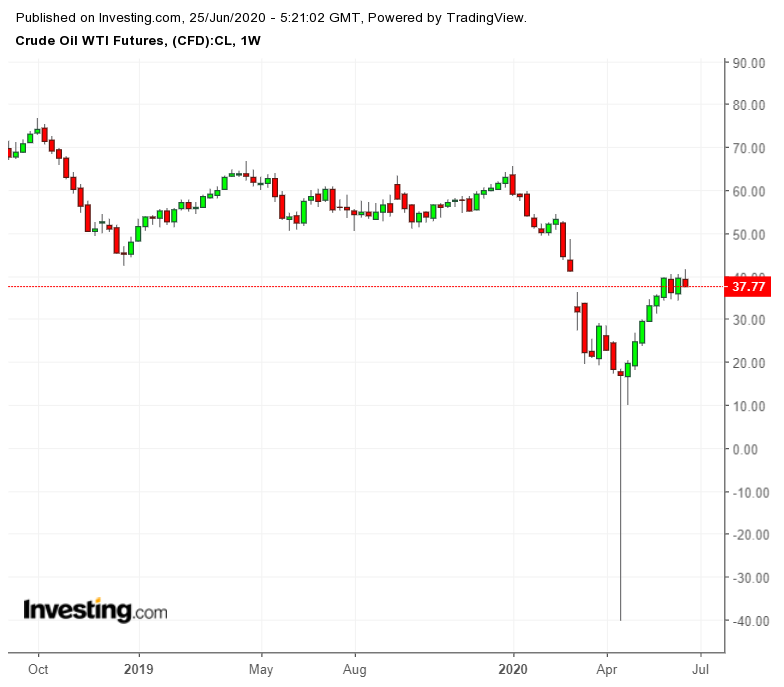We all know that there’s too much crude oil on the market right now. Even with record declines in U.S. oil production and the so-called historic production cut by OPEC and Russia, global oil inventories were 1.4 billion barrels higher at the end of May than they were at the end of 2019, according to the EIA.

Demand for crude oil products like gasoline and jet fuel is starting to pick up, but three paramount issues in the refining sector continue to stand in the way of increased crude oil prices. These problems will likely weigh on prices for some time.
1. Product Oversupply
While there is already an oversupply of refined products in the market, countries around the world continue reporting higher than average inventories for various fuels.
Indonesian refiner Pertamina estimates that it has 42 days worth of diesel fuel and 28 worth of gasoline in inventory, whereas it typically stores only 20 days worth of each. India reports stockpiles of both transportation and industrial fuels that will last 10-15 days compared to the usual 7-10 days.
In the United States, API reports that at the end of May, U.S. stocks of gasoline (this includes reformulated, conventional and blending components) were 9.5% higher than in May 2019. Crude oil inventories will not start to clear until headway is made on the glut of petroleum products.
Although consumption is accelerating, it is still about 18% lower than it should be for this time of year. The more refineries ramp up their work, the longer it will take to decrease the oversupply of products.
2. Refinery Capacity Utilization: Still Too High
Refineries are processing less crude oil and making less product than they typically do for this time of year. In the United States, refineries operated at their lowest rates (called refinery capacity utilization) on record for the month of May.
To put this in context, in May 2019, refinery utilization was at 90.6%. That dropped to 70.6% in May 2020. This might seem like a positive sign because lower refinery rates should mean that petroleum products inventory is being drawn down. However, demand for these products is still below average.
For example, the EIA reported that last week 7.98 million bpd of motor gasoline were supplied to providers compared to last year’s 9.68 million bpd. In addition, refineries produced 8.3 million bpd of motor gasoline during the same week.
Some of that gasoline will be exported, but we can see that even at reduced rates, refineries are still producing too much motor gasoline for current consumption levels to draw down the excess inventory.
3. Low Margins Disincentivize Higher Refining Runs
According to the Wall Street Journal, refining margins for U.S. refiners have dropped significantly since mid-March. We would expect some economic relief for refiners given the low price of crude oil (which they purchase to make product).
However, profit margins are low. In January and February of 2020—before the virus-caused economic collapse—the profit for U.S. refiners ranged from approximately $16.40 to $20.00 per barrel. Since mid-March, those profits have dropped to $7.50—$14.40 per barrel. Refining margins are even worse for European and Mediterranean refiners buying Russian crude oil, which has become more expensive since Russia slashed oil production. Because of lower margins, refiners have less incentive to produce more products and use up the crude oil in inventory.
Right now, it looks like some OPEC countries and Russia are preparing to raise production at the end of July (unless the group decides to extend its current quotas for another month), and production in the United States could tick up as some producers have plans to reopen shuttered wells.
Increased output will be a negative force on oil prices, but without concurrent growth in demand, refining margins don’t seem poised to grow enough to catapult refining margins into the ranges needed to incentivize higher runs.
In addition, this will likely catch U.S. refiners at the same time in the season that they typically cut refinery runs to complete maintenance and switch over to winter gasoline blends.
All of this points to a much longer and more drawn out recovery period for oil prices. While prices will undoubtedly spike on geopolitical and market news, it’s unlikely they can start to trend higher until the underlying conditions blocking the flow of crude oil to refineries to the consumer are resolved.
Note: Some of the crude oil glut could also be alleviated as we will likely see some increase in direct crude oil burn in countries like Saudi Arabia, UAE, Kuwait, etc. this summer. These countries have cut production, which means they are producing less associated natural gas needed for their power plants while electricity demand skyrockets due to the hot summer months. Their power plants will probably have to burn more crude oil than expected this summer to keep residents cool.
